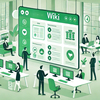
The field of technical communication is vast. It encompasses forms of communication that can help users accomplish a defined goal or task. Strictly speaking, any text intended to convey information about using technology is considered “technical communication.” Technical communicators specialize in website design, graphic design, marketing communications, online help, print production, training, and technical documentation. The role of a technical communication specialist is varied. There are a lot of job opportunities for technical writers, and along with tech writers, there are technical editors, or at least there should be in an ideal world.
What Is Technical Editing?
Technical editing is a collaborative process of generating content with authors to check the correctness of specialized terminology, equations, and combinability of textual and visual elements.
It is iterative and not a one-time routine. Technical editors often review the same materials numerous times, and before the documentation is printed or published online, their edits are reviewed. The situation when a technical editor makes changes and then publishes the materials immediately is exceptional.
Technical editing covers the same wide variety of subjects, contexts, and materials as technical writing.
What Does a Technical Editor Do?
A user-focused approach to appropriately providing the correct information at the right time to make a user’s life easier is what all technical communicators have in common.
A good editor can see the big picture together with the subtle details and can play a vital role in documentation projects.
A primary task of a technical editor is to provide expert-level reviews of content for structure, inconsistencies, technical and grammatical errors. In addition, the editor updates, corrects, and suggests improvements for authors’ materials.
The roles of a technical writer and technical editor may vary considerably depending on the industry. A technical editor:
- Is involved in a writing project from the planning stage through to completion;
- Plans the documents necessary for a project;
- Coordinates the production of several documents on one product;
- Sets standards for the company’s publications;
- Determines the suitability of the material for the target audience;
- Advises writers on the appropriate use of graphics, the wording of headings, figure and table captions, page breaks, and index and glossary entries;
- Supervises graphic artists and editorial assistants;
- Performs whatever levels of edit are necessary.
Types of Technical Editors
Robert van Buren and Mary Ann Buehler have a great paper, The Levels of Edit, 1980, which divides editing into nine types of edit. But most organizations tend to divide editing into three types: developmental editing, copy editing, and proofreading. Depending on a specific scenario, you might need all three.
Responsibilities of a Technical Copy Editor
Copy editing is the first that comes to mind when thinking of editing work. It is the most commonly requested editing service. This work starts after your document is finished and demands an edit pass for grammar, structure, consistency, readability, and adherence to any relevant style guides.
A copy edit includes a review of:
- Adherence to style guidelines;
- Grammar;
- Spelling;
- Sentence structure;
- Passive vs. active voice;
- Proper use of terminology and capitalization;
- Parallel structure;
- Link verification;
- US English language/dialect;
- Image review: relevant to surrounding text, clean, easy to read, properly numbered/captioned;
- HTML/markdown check.
Responsibilities of a Technical Developmental Editor
With a developmental edit, the editor becomes the writer’s co-contributor in producing the document. On this level of editing, you determine the direction of the document or what needs to be revised or reorganized in the document significantly. If you want to confirm the efficiency of your document or the proper structure, ask your editor to do a developmental edit. Your editor works closely with you and your SMEs, developers, and product owners to ensure the best possible results.
A developmental edit includes:
- Assessment of how well a document delivers on its goals;
- Expert-level review and fact-checking of technical content;
- Verification of code examples;
- Review of the usefulness and accuracy of images, or places where images are/aren’t needed;
- Evaluation of accessibility to the typical reader;
- Review of flow, structure, and organization;
- Fine-tuning of clarity;
- A thorough check for consistency;
- Evaluation of voice and tone;
- Revision of some sentences and suggestions for rewrites.
Responsibilities of a Technical Proofreader
Proofreading is the final stage of editing. It is made when the documents are considered done. The last validation is made right before publishing. At this stage of editing, your document has been reviewed, updated, and cleaned up. A proofread is a checkup to ensure that no errors were introduced during final drafting or design and that nothing important was overlooked during the copy-editing process.
Proofreading includes:
- Spell check;
- Link check;
- Formatting or pagination problems;
- Typos or other errors;
- Anything overlooked on the main edit pass.

What Skills Are Necessary for a Technical Editor?
Technical writing and editing skills are highly associated with each other. Here is the list of skills a person should have to be considered an experienced technical editor:
- Technical skills. Often known as hard skills. These skills are the abilities and knowledge needed to perform specific tasks. They are earned from experiences or education.
- Technical writing skills. The apparent skill for the one who edits documents to be read. Of course, this skill is developing with constant practice.
- Grammar skills. Grammar is an essential part of technical writing and editing — documentation should be grammatically correct. Technical editors need to learn and understand the basic rules of the language.
- Research skills. Editors are dealing with various content they may have never heard of. Editing software documentation under such circumstances is a tough call and requires expertise. Hours of thorough research can help gather enough information on the given field to start editing. These skills also help to live up to the quality expectations of your clients and perform troubleshooting.
- Design skills. Graphic design is the art of making visual content to communicate messages. These skills are needed if you are a graphic design editor and can help with technical document editing.
- Knowledge of technical writing and editing services and applications. There exist a lot of tools to write and edit technical documentation. Knowledge of MS Word is not enough these days.
- Knowledge of HTML. HTML or HyperText Markup Language can be defined as the standard language for developing web pages. It is a formatting system that describes the layout of the web pages and the foundational language for every web page.
- Programming languages. Technical communicators working in software companies must know at least the basics of coding to be able to understand how things work since technical editors are supposed to review different types of documentation like API documentation, knowledge base articles, instruction manuals, and so on.
- Interpersonal skills. Written documents benefit when the writer and the editor work collaboratively as early in the process as possible. As editors immersed in the writing act, they gain a better understanding of the writer’s perspective and of the difficulties encountered when one tries to express abstract ideas in clear writing.
- Coaching skills. These skills may be needed to train technical writers or editors on stylistic guidelines, procedures, indexing, and online searching.
- Problem-solving skills. A technical editor should be able to find out potential problems of users and tell them how to solve such things. There may be several ways of solving a problem. The editor must analyze all of them and choose the best one for users.
- Self-learning ability. The sphere of technical communication is changing constantly, and technical editors must refresh their skills all the time.
Technical Editor Job Description
It’s hard work to become a technical editor, but even the most dedicated employees consider switching careers from time to time. In accordance with the Bureau of Labor Statistics:
In the USA, a technical editor’s annual salary averages $54,291.
Here are the responsibilities demanded from a technical editor (example taken from a resume):
- Design, create, and maintain SharePoint 2010 internal sites and content.
- Established and maintained communications among local and remote employees and teammates using collaborative tools (e.g., SharePoint).
- Managed deadlines while working with Subject Matter Experts for article accuracy of deliverables.
- Revised graphics with Visio graphics package.
- Cover News Events Write Articles Photography Copy Editing.
- Assisted in the creation of an online letter-writing tool.
- Trained new assistant editors.
- Manage a full-time staff of up to seven people and numerous freelance contributors.
- Created news stories and packages for anchors reporting on live television- Utilized Adobe Premiere and Adobe Auditions for editing and sound mixing.
- Selected news stories for Page 1 of a metropolitan daily newspaper, designed pages, edited stories, wrote headlines.
- Reviewed HTML, SGML, and PDF files prior to an online posting.
- Designed 6-10 pages during every print night, including layout for the sports section.
- Arranged for photography, artwork, and illustrations with graphic design and photography departments.
- Designed the Opinion page using Adobe InDesign.
Of course, the more you can do, the higher the salary you’ll get.

Conclusion
A technical editor has a wide range of responsibilities with respect to readers, writers, clients, and organizations. The editor advocates for the user’s point of view, collaborates with writers and SMEs, and ensures that each piece of content meets organizational objectives.
A technical editor plays a distinctive role in the content creation process and can offer many benefits to a writing team or organization. In reality, however, many writers work without the aid of an editor and assume some or all of the editor’s responsibilities. In these situations, writers need to be aware of the many considerations that editors face and understand how to maintain positive relationships with other writers.
Good luck with your technical writing!
ClickHelp Team
Author, host and deliver documentation across platforms and devices



